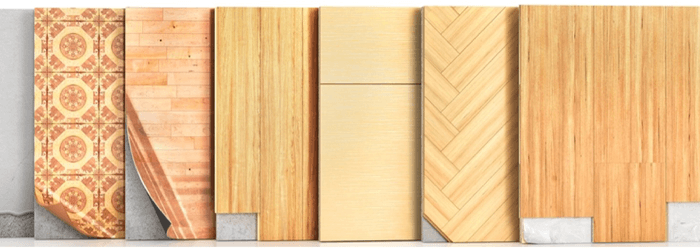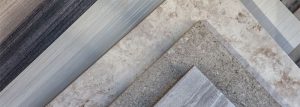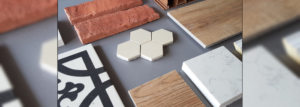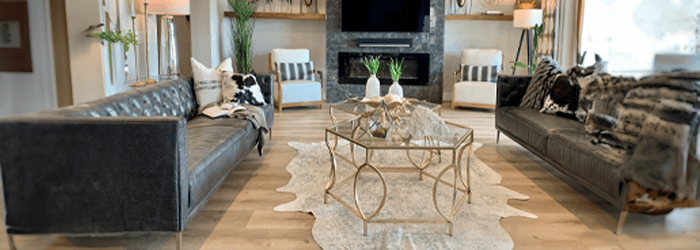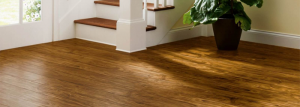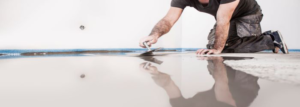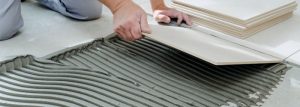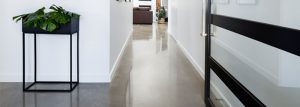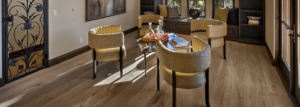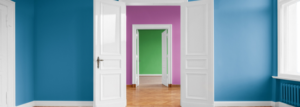How To Choose Flooring
Updating old flooring can make a huge difference in the feel and comfort of your home. With so many materials, styles, and installation options to choose from, where do you start?
According to our experts at Bram Flooring and Mission Hardwood Floors, the two most important things to take into consideration are your budget and lifestyle.
In this article we will cover solid wood, engineered wood, laminate, vinyl, tile, and carpet.
Budget & Lifestyle
Budget
You want to get the best quality flooring for your budget. For example, don’t get your heart set on natural stone floors if your budget is small, especially for a large area. Be sure to pad your budget for more flooring material than you need in case there is a problem with the installation or damage occurs.
If it has been a while since you installed new flooring, you may experience sticker shock. As with all building materials, its cost has gone up. Do your research before heading to the store. And speaking of the store, our flooring experts recommend shopping at the smaller flooring stores, as you will get the best value.
Rosie’s tip: You will have to order enough to account for all the cutting that will be necessary. The more irregular the shape of the space, the more you will have to allow for waste due to cutting. It’s never a bad idea (if you have the room) to order some overage to replace any damage that might occur over the life of the new floor material.

Lifestyle
Your household’s lifestyle is very important to consider when thinking about selecting flooring. The more people and pets in the home, the higher the incidents of spills and other damage. Consider going with flooring that can withstand food and drink spills, pet stains, and pet hair. Select flooring that can easily be wiped down after spills and splatters. Carpet and porous tile won’t fare well in those instances.
Want to keep the noise down? Stay away from tile. Designing a workout room? Try cork flooring. Updating a formal living room? That is the place to more strategically spend what you need.
Entryways, family rooms, hallways, and other high-traffic areas tend to be the dirtiest and therefore require durable floors. Choose something of high quality with great durability.
Regular and proper maintenance is essential to keeping your flooring looking new. Any type of natural stone, although very high-end, requires the most time and effort to maintain. Don’t splurge on expensive flooring if you are not willing to set aside the allotted time to keep it up. Flooring like concrete, terrazzo, or natural stone requires seal maintenance.
Flooring Types
Solid Wood
A solid hardwood floor can make a room look warm and homey.
A genuine hardwood floor is made from three-quarter-inch strips of solid wood. Wood floors are available in at least 50 species. The most popular hardwood species used for solid wood floors are red oak, white oak, ash, and maple. They can be painted or stained any color.
Because solid wood expands and contracts when it is humid, manufacturers do not recommend installing them in basements or directly over a concrete slab.
Benefits: Aside from looking warm and beautiful, wood floors are extremely popular. Houses with wood floors tend to sell faster and for more than homes with other kinds of flooring. A natural resource, wood is renewable and recyclable.
Challenges: Solid wood expands and contracts when it’s humid. Wood floors are sensitive to moisture, so manufacturers do not recommend installing them in basements (which are not common in Arizona) or directly over a concrete slab. Because solid wood floors must be nailed, you’ll have to install a subfloor if you want to place it over a concrete slab.
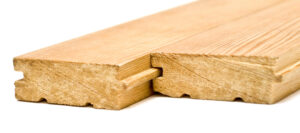
Maintenance: Sometimes called the “100-year floor,” solid hardwood typically is finished with a thick, durable topcoat that protects it from damage. That protective coat can last for 10 or more years. When it’s time to refinish the floors, they can be sanded and refinished up to 10 times over their lifetime because they’re so thick. In between refinishings, all a wood floor requires is sweeping and dust-mopping. Clean up spills and stains with a cloth that’s barely damp or with a dab of water-based wood floor cleaner.
Cost: A solid wood floor can get expensive. Installation adds to the cost.
Engineered Wood
A favorite among Arizona remodelers, engineered wood is a product with multiple layers — the top layer is solid wood, so it looks and feels like the real thing. Plus, it can be installed directly on a concrete slab.
An engineered hardwood floor is made from three to five thin layers of wood, stacked in a cross-grain pattern and laminated together to form one plank. The top layer—the one that you see—is made from 1/4 – to 1/32-inch of the high-quality wood of your choice.
Benefits: Because engineered hardwood floors are made from layers of wood stacked in opposite directions, they don’t expand and contract as much on humid days as solid hardwood floors. Engineered floors can be nailed, stapled, glued, or even floated over most kinds of subfloors, including concrete slabs. This makes them a popular choice in Arizona.
Challenges: Because the beautiful wood layer—the top layer—of an engineered floor is as thin as 1/32 of an inch, you won’t be able to sand it down and refinish it more than a couple of times. Rosie recommends that you select an engineered floor with a top layer that’s no thinner than one-eighth of an eighth of an inch. Engineered wood needs 30-40% humidity.
Maintenance: Engineered floors call for the same simple maintenance as hardwood floors: regular sweeping and dust-mopping. Spot-clean tough messes with a slightly damp cloth or a water-based wood floor cleaner.
Cost: Around the same price as solid hardwood floors. Installation adds to the cost.
Laminate
A laminate floor looks like wood, stone or tile, depending on the pattern you select, but it’s not—so it costs less and keeps its like-new look for longer. Each generation of laminates looks more realistic and holds up better when it gets wet.
Laminated planks are made from processed wood chips, which have been ground to dust. The wood fibers are mingled with resins to make the product moisture resistant. That mixture is pressed at high pressure and heat to make a board, which is overlaid with paper that bears the likeness of the wood, slate, or tile that the product intends to mimic. The paper is impregnated with melamine for structural stability and then overlaid with a wear layer that resists scratches, dents, and everyday wear and tear.
Pergo, is a brand name for what is properly called laminate flooring. It’s a highly durable, low-maintenance imitation wood floor. It is actually a plastic laminate photo image of wood that is applied to a composite wood substrate. Our flooring experts tell us that Pergo is no longer “a thing.” It was very popular and easy to install, but since then, higher quality products have entered the market.
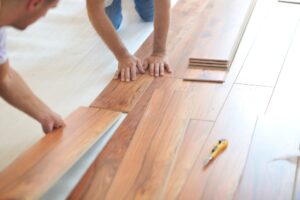
Benefits: A lower-cost alternative to solid or engineered wood, laminate floors are stain-resistant, will not fade when exposed to sunlight, and won’t burn, even if you drop a cigarette. Plus, laminate floors are a cinch for the handy do-it-yourselfer. You don’t have to nail them to the subfloor; they’re glued or they “float.”
Challenges: Their biggest drawback might be the noise they make when you walk it. Laminate floors sound a bit hollow. Most manufacturers sell special underlayment pads that help alleviate the noise. The floor you lay the laminate planks on must be extremely level. Also, if you manage to damage a laminate plank, it’s not easy to repair.
Maintenance: Laminates are easy to care for. Just sweep your floor with a dust mop to keep the dust away, and spray on a bit of manufacturer-approved laminate floor cleaner to pick up spills. Caution: while newer versions of laminate floors are more resistant to water than older generations of the material, they are not designed to perform in standing water. Clean up wet spills and tracked-in mud quickly to avoid problems. Be cautious when steam cleaning.
Cost: Laminate flooring can be among the least costly flooring options. Most prices include underlayment.
Vinyl Flooring
Wood laminate is on the way out according to Bram Flooring. The modern choice is a vinyl core product. When talking about vinyl flooring it’s important to identify what type of vinyl you want for your home – sheet vinyl or vinyl laminate.
Sheet Vinyl is an inexpensive option, mostly used in rentals and trailer homes.
Benefits: Extremely cost effective, very similar in cost to carpet.
Challenges: Very soft and susceptible to damage from moving furniture or heavy objects, denting can occur.
LVP / Click lock Vinyl / Vinyl Laminate can be tricky to navigate due to the fact that according to Bram Flooring, the manufactures have not settled on an industry standard name for it just yet. What you, the homeowner, should know is that this product choice is essentially a laminate floor, but instead of the construction being comprised of wood product, it is a plastic core with a vinyl top layer. The core can be either SPC (Stone Plastic Core) or WPC (Wood Plastic Core).
The top layer is a vinyl film with a wear layer (clear coat) over it. These wear layers come in different thicknesses, 6-, 12-, 20- and 30-mil (thousands of an inch). This is used as a selling feature. It is important to understand that anything 12-mil or above is more than adequate for residential use.
The total thickness of the product can range from 4mm to 12mm. This feature is important because the durability of the locking system will break down over time with thinner products. The 7mm is standard for a quality product.
Another consideration is the prints-per-batch. Low-cost products will have more repetition in the planks, therefore creating a false wood look. Higher-cost products will generally have a high prints-per-batch count helping them emulate real wood.
Benefits: Easy to care for and clean. Quiet to walk on. Softer on the feet than tile. No added cost for yearly upkeep. Fairly easy to install, but can be tricky. No dry time — it can be walked on immediately. Furniture denting is not an issue.
Challenges: Can scratch with heavy items or small rocks, although scratched planks can be replaced with leftover material. Because installation can be tricky, READ THE DOCUMENTATION provided, as this is the best way to maintain your warranty through the manufacturer.
Maintenance: Sweep and mop with a neutral cleaner. Sealers or other maintenance is not required.
Cost: Most products are equivalent to the cost of ceramic or porcelain tile.
Tile
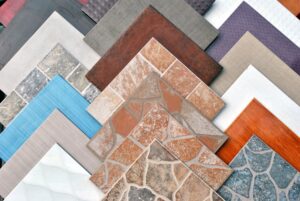
There is an abundance of tile materials including ceramic, porcelain, Saltillo, marble, travertine, and granite to name a few. There is tile that is manufactured to look like wood planks. While travertine is still popular, porcelain tiles that look just like travertine, wear better and need less maintenance are gaining ground.
Benefits: You can get as creative as you want with tile layout and designs. Tile is very durable, water-resistant, and easy to maintain.
Challenges: It can be cold and uncomfortable to stand on. The grout can become discolored if not kept clean and sealed.
Maintenance: With regular sweeping, tile is fairly easy to maintain. However, the grout will require an on-going cleaning and sealing regiment.
Cost: It can be one of the more affordable flooring materials. However, the higher quality you choose and the more intricate the installation, the higher the cost. Natural stone tile can be costly.
Carpet
Carpet is still a good option because the cost is generally less than half of hard surfaces. If you choose carpet, be sure to buy high-quality, nylon products with good stain protection. Don’t skimp on padding. Seven-sixteenth of an inch is the industry standard. Installing the wrong pad could void your warranty.
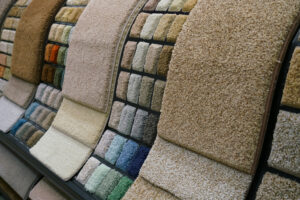
Benefits: It is soft, warm, and comfortable to stand on for long periods. It retains warmth which makes it ideal for bedrooms. Carpet cushions falls and dropped items better than other flooring types. It also reduces noise. There are many colors, patterns, and fibers to choose from.
Challenges: If not treated to repel liquid, it will absorb spills, resulting in stains. Moisture can seep into the pad, creating mold and mildew. Pet stains and odor can be difficult to remove. If not maintained, carpet can wrinkle, which not only looks bad, but is a trip hazard. Not great for the bathroom.
Maintenance: Carpet needs to be vacuumed once a week to keep it from looking dingy and to poof up the fibers. Annual, professional cleaning may be required to maintain the warranty.
Cost: Among the lower range of flooring options, carpet costs vary depending on the material, pile, pattern, and padding.
Trendy Can Be Spendy
Be cautious of going with the trend of the moment. Trends come and go. In five, 10, or 15 years, will you be happy with the look? If this isn’t your forever or even five-year home, consider a flooring that will add to the look and resale value of your home when you’re ready to move. If you are planning on living in the home through your golden years, you may need flooring that offers flexibility.
###
Podcast
Updating old flooring can make a huge difference in the feel and comfort of your home. With so many materials, styles, and installation options to choose from, where do you start? We discuss the points to consider from the most popular flooring to what’s on the way out with budget and lifestyle in mind.
Rosie-Certified Content Partners
Photo Credits:
- Shutterstock
Resources & Related Content

